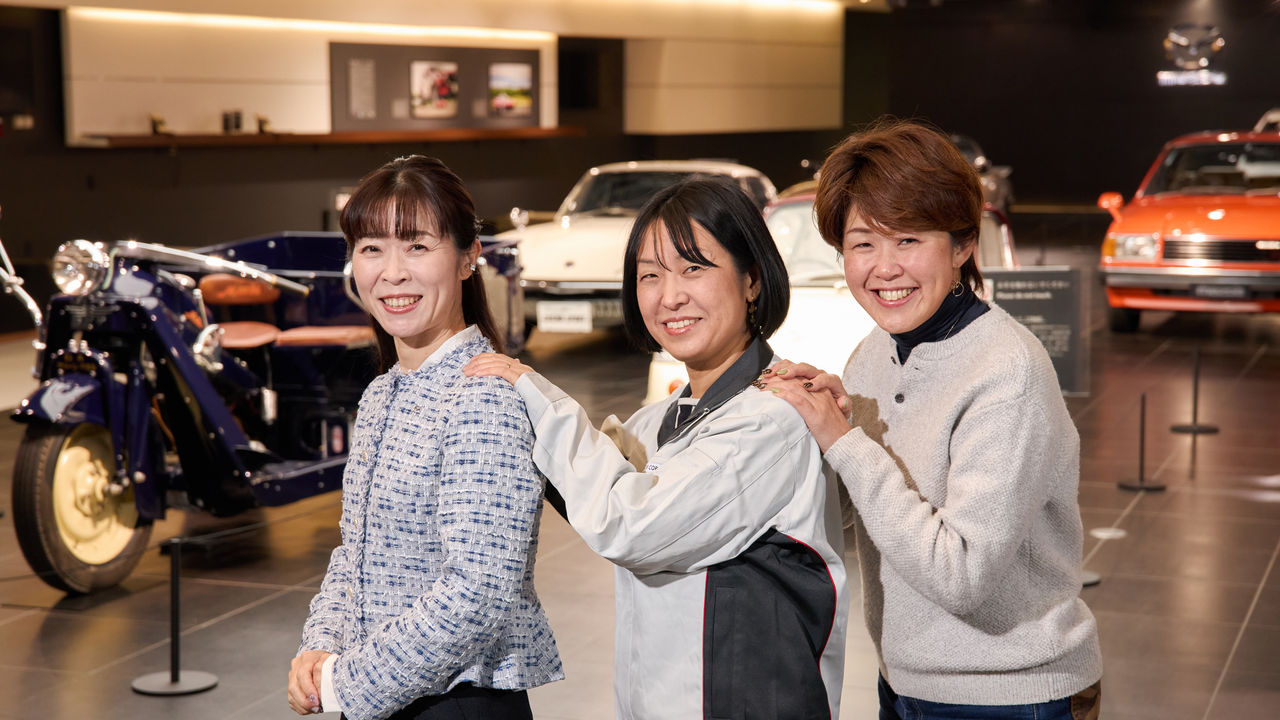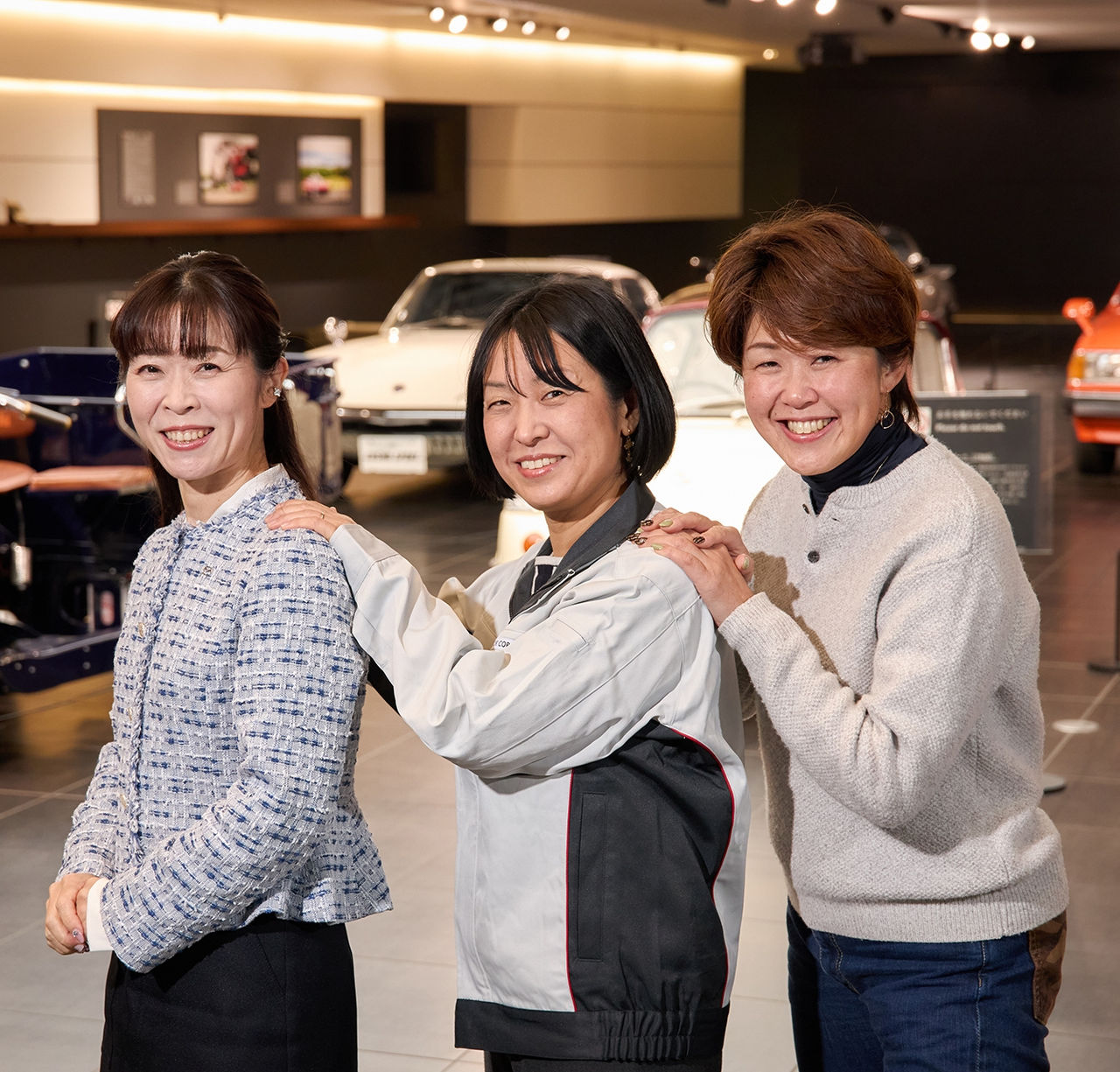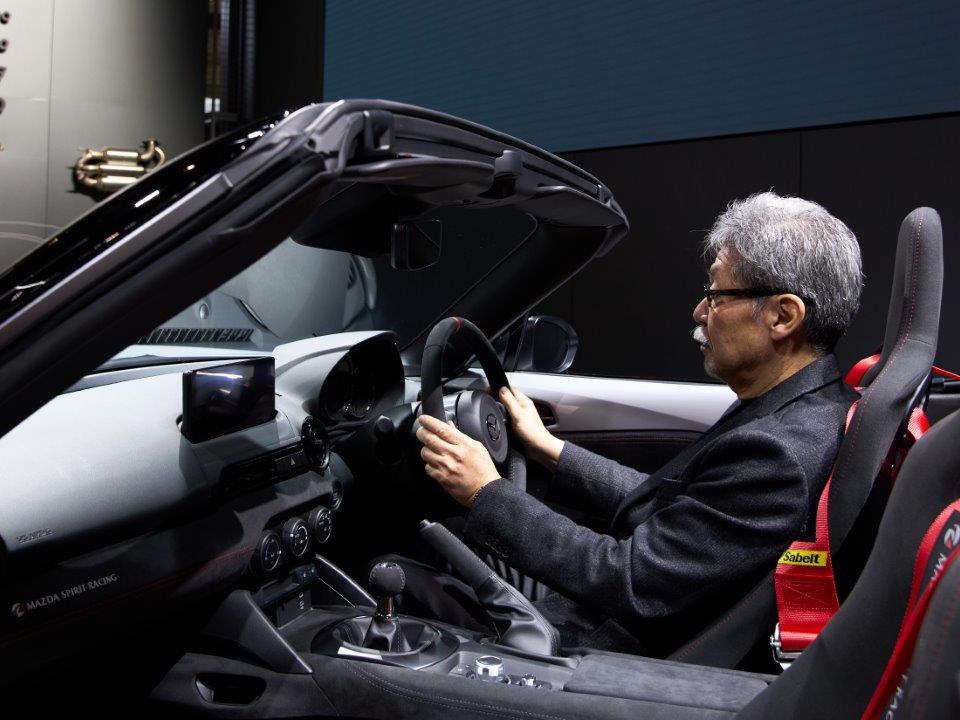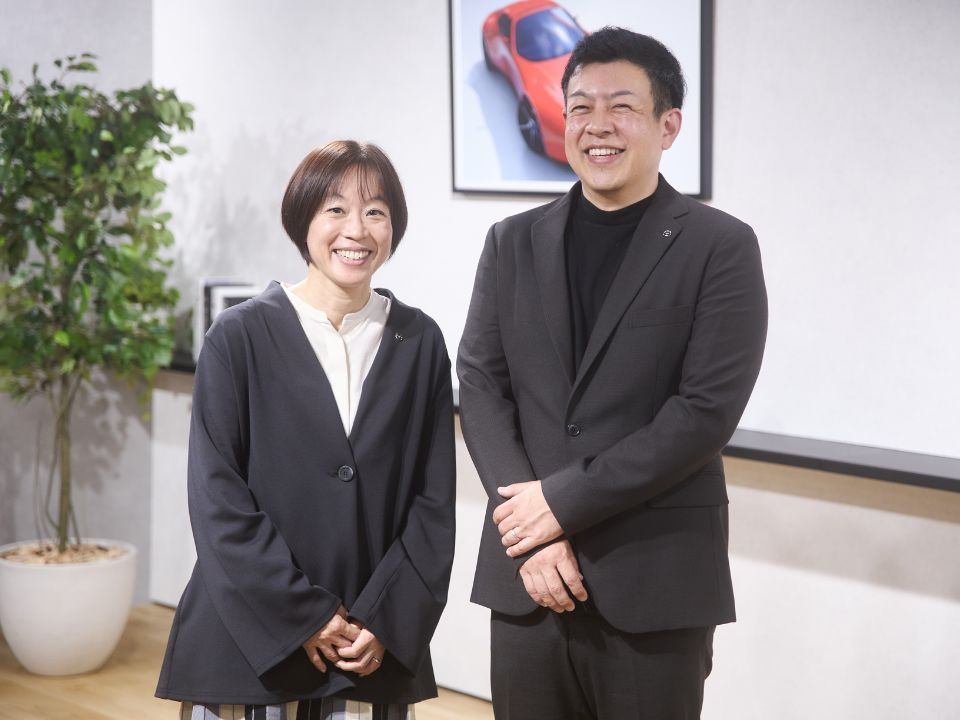2025.04.02
Pioneering Women at Mazda: The MX-30 Program Managers Passing on the Baton of Innovation
The concept for the Mazda MX-30 compact SUV was born from a simple yet powerful idea: to create a driving experience where drivers can truly be themselves and live authentically.
This groundbreaking concept has been guided by three pioneering women, beginning with Mazda's first-ever female Program Manager*, Tomiko Takeuchi. The role later passed on to Wakako Uefuji and then Mitsuyo Okadome, each bringing fresh perspectives from entirely different parts of Mazda.
As Program Managers, they’ve coordinated global teams of nearly 1,000 professionals, transforming a concept into a car that brings meaningful impact to people's lives. What unique strengths do these leaders bring to the role? What have they discovered about Mazda’s human-centric philosophy along the way? We sat down with all three to find out.
※A Program Manager oversees every aspect of a vehicle's journey, from initial development and production to sales and service.


The Mazda MX-30. Developed by Takeuchi and advanced by Uefuji and Okadome.
"This is big!" Honest Reflections on Leadership Appointment
Takeuchi:
At the time, I was working in the Vehicle Development Division, in charge of performance development for the Mazda 2. I was at a test drive event in Kagoshima, and as I was getting ready to leave, an executive called me over and approached me about the position. It was completely unexpected. I remember thinking "This is big!" as I made my way back to Hiroshima.


Tomiko Takeuchi. Joined Mazda in 1997. After working as a test driver and overseeing Mazda 2 performance development, transferred to the Product Division in 2015 and led MX-30 development as Program Manager. Moved to Human Resources Division in 2021. Currently serves as Executive Officer and CHRO (Chief Human Resource Officer) in charge of Safety, Health & Disaster Prevention and Mazda Hospital, focusing on people's health and safety. “It’s like my child,” Takeuchi fondly says about the MX-30. “I’m on my second MX-30 but I’m already planning for my third.”
Uefuji:
When I was approached, I was working in production technology, an area quite different from vehicle development, so it came completely out of the blue. The day before my interview with the executives, I was at the park with my child, swinging in a hammock wondering what I should do. During the interview, the more I talked, the more anxious I became. I knew that overselling my abilities wouldn’t help anyone in the long run so I was honest about my weaknesses and concerns. I was grateful for the opportunity to challenge myself, but at the same time, I lacked confidence in the beginning.


Wakako Uefuji. Joined Mazda in 1998. After 12 years in the Painting, Trim & Final Assembly Engineering Department managing paint process preparations for new vehicle models across Japan and international markets, took a career break of over three years to accompany her husband on overseas assignment and for maternity and childcare leave. Returning after the break, was responsible for human-centric process design in production. In April 2021, appointed Program Manager for the MX-30. From April 2024, appointed Department Manager of the newly established EV Production Engineering Department. Taking her cue from the MX-30, Uefuji is currently exploring what it means to live authentically.
Okadome:
At first, I thought it was a mistake (laughs)! I was working in logistics which is very different to development. But my husband works in development, so when I got the email, I thought it was meant for him not me! As far as the role, all I knew about being a Program Manager was that it had something to do with product development.
At the same time, I knew that someone had to take the position. So, I thought, “Well, why shouldn’t that someone be me?”. I immediately accepted, which seemed to surprise them a little at first!
I’ve always been someone who enjoys growing and changing. Since joining Mazda, I’d enjoyed a rewarding career in logistics for 24 years and I was at a point where I was thinking about my next challenge. I saw this as a once-in-a-lifetime opportunity to change my path and I jumped right in.


Mitsuyo Okadome. Joined Mazda in 1999. 24 years in logistics operations, including factory and warehouse launches and logistics for components and completed vehicles. Appointed MX-30 Program Manager in April 2024. Lives by the motto “Never stop smiling.” “Of course, the real challenge is how to keep smiling during the good and the bad times.”
Creating New Value with a New Team. Leaders Open Up About Their Struggles
- Takeuchi, what was your brief at the beginning of the project regarding what kind of car to create?
Takeuchi:
"Create new value" — that was literally the only brief I got from management. Nothing else was decided.
At first, I focused only on technology and functions. But, after meeting and listening to professionals in Japan and overseas, I arrived at a new value that wasn't tangible: space and time.
We can't predict what advanced technology will look like five years from now, but we can be certain about one thing: we'll be busier and be subjected to even more information. When I envisioned a world like that, I wanted to create a car that would give you a sense of calm from the moment you see it, open the door, and sit inside. A car that provides a space and time to relax and find peace. It took me two years to land on that idea, but it was worth it to find a value that was wholly unique.
Uefuji:
I love this story. I remember asking Takeuchi the exact same question back when I first started. I wanted to know what it means to create something from scratch.


- Uefuji and Okadome, coming to this role from very different fields must have presented its own challenges?
Uefuji:
Yes. For starters, I didn't understand a lot of the terminology used in the meetings. But I was determined to make a success of the role and lack of knowledge was no excuse. If there was something I didn’t know, I’d be open and simply ask for clarification until I understood.
Okadome:
There are so many terms used internally, both at Mazda as a whole and the development team in general. It’s almost as if specialists have their own language sometimes. I saw myself as the developer closest to the everyday user and made a point to ask questions to make sure that not only I, but anyone within or without the company could understand what was being discussed.
Uefuji:
The support of my team was invaluable in helping me overcome those challenges. During transition, Takeuchi said, “The best asset I can leave to you is this team, both the people and its culture are incredible.” Team members come and go, but the culture established by the original members has remained.
- Were the team dynamics always this great?
Takeuchi:
No, not at all (laughs)! The Chief Designer and the Program Manager should function like partners in a three-legged race, but we kept clashing at the beginning. Every time the designer proposed exciting materials or forms, I’d counter with cost concerns: “So, I’ve found this great new material and I’m thinking of using it for this…” “Do you have any idea how much that’s going to cost us???” It was a constant back-and-forth battle!
Okadome:
Kind of like a married couple (laughs)!


Takeuchi:
Yes, exactly (laughs)! And like a couple, the more we talked the more common ground we found. Ultimately we realized we both care deeply about the project. Our goal is the same, we clash because our positions are different. Once we two reached an understanding, other team members began to connect with our goal and our circle of collaborators gradually expanded.
The MX-30 is Mazda's first mass-produced electric vehicle, so there were countless unknowns. We needed members who were flexible and agile; we couldn’t have people drawing lines and saying “That’s not my job.” This fostered an environment where everyone could work together without being fixated on their specific roles. Eventually, I could take a more hands off role, offering support only when needed.
- That’s an inspiring story that really captures the joy of teamwork and collaboration.
Takeuchi:
Thank you. I was able to overcome so much because of the amazing people on my team. I remember how the Chief Designer would lend me the interior model when I felt I’d hit a wall. It was the only full-scale model with a driver and passenger seat where we could experience the MX-30 before release. It was funny, but sitting inside always helped calm me and regain my sense of self.
While there were times when I felt the loneliness of leadership, my team were always there to support me and help me find my way.
- Uefuji and Okadome, did you ever feel lonely as a leader?
Uefuji:
In the beginning, a little. Moving from a familiar workplace to a floor where I didn't know anyone was daunting. But when I arrived at the office, Takeuchi’s big, welcoming smile helped me feel a lot more confident about the move.
Okadome:
To be honest, I’m not the kind of person who experiences loneliness. I think that loneliness is often a result of not being open about our concerns and struggles. Mazda has a great culture; people here are very supportive. As long as I let people know how I’m feeling, there’ll always be someone willing to step up and help. Mazda people are like that.


Discovering the Limitless Power of Human Potential as a Program Manager
- It's impressive how all three of you were able to build trust as leaders while also accepting the support of your teams.
Takeuchi:
I love cars, and to be honest, I’ve always found cars much easier to relate to than people, and just easier to interact with. But as Program Manager for the MX-30, watching team members move from early-career roles learning the ropes to providing valuable support in just a few years, I began to see people in a new light. It completely changed my outlook.
Uefuji:
There were so many times where I was reminded of the amazing power of human potential. How much capability we have, how much grit. Robots and AI are incredible, but nothing beats us humans!
- Cann you give any examples of where you felt this most?
Takeuchi:
Sure. Mass production of the MX-30 was scheduled to begin on May 19, 2020. Then the COVID pandemic hit. At the end of April, Mazda implemented a company-wide shut down. This came just before the Golden Week holiday and could mean a significant delay. At that moment, I felt my heart drop. I knew that not meeting our production start date was now a real possibility.
Then I started receiving calls from project leaders throughout the company. They wanted me to get special approval for certain team members so that they could come to work and continue with the project.
I was incredibly moved by their determination not to give up, despite the difficulties we faced. There was no instruction manual for how to handle this situation. I witnessed the true power of human potential as we sought a solution in a crisis.
Uefuji:
During my time as Program Manager, we kicked off the project to equip the MX-30 with the rotary engine—Mazda's proprietary technology and the first in the world to be successfully commercialized. We faced challenge after challenge around mass production feasibility, but everyone refused to give up until we could succeed. People who work at Mazda are incredibly dedicated, many of us are stubborn to the extreme when it comes to seeing things through. This means we have a pro-active attitude to challenges, focusing on the solution rather than the problem. It was really inspiring to see that in action.


- What is your definition of a good team?
Takeuchi:
A team where each member shares one clear goal is a very powerful force. For the MX-30, in addition to creating new value for customers, as Mazda's first mass-produced electric vehicle, we were also focused on making sure that there were zero quality issues.
Yet even with the same goal, we’re all approaching it from different positions and it’s natural for opinions to clash. I see the team leader's role as creating an environment where everyone can express opinions freely. When a member has an opposing view, there’s a reason for that. As a leader, it's extremely important to actively listen and create a space where team members can listen openly to each other's opinions.
- How do you achieve this?
Takeuchi:
My policy is: listen first, speak second. Active listening requires a lot of patience. But having a genuine interest in others' opinions and listening empathetically is the way to good communication. Listening is how you can truly create a foundation where people are willing to listen to you too. And that’s when you can finally share your opinion.
- Would you agree, Uefuji and Okadome?
Uefuji:
Yes, my approach is almost identical to Takeuchi’s and it’s encouraging to know we think the same way. If we practice active listening as Takeuchi described, we can see the team's challenges as our own. When we take accountability for an issue, that’s when we show real strength.
Okadome:
Yes, and I always think it’s important to step into the other person’s shoes when listening. My father used to say that people who have reached higher positions have experienced each rung of the ladder, giving them perspective on the entire landscape. But those earlier in their journey only know the environment where they are now. In other words, those of us in leadership positions are more able to place ourselves in the other person’s shoes, because we’ve been there.
It gives us more perspective, enabling us to suggest a different approach and help them think out the box. It’s a way of thinking that can improve the whole team's capabilities.


The MX Challenger Spirit: Maintaining Innovation Across Changing Departments and Roles
- Uefuji and Okadome, why do you think the last two people appointed to this role have both been from other departments?
Uefuji:
Good question! At Mazda, we use the MX prefix for cars that represent a unique challenge. For example, the MX-30 had to create new value, it's Mazda's first mass-produced electric vehicle, and it involved many new technological innovations.
In that same spirit, Mazda took on a challenge by appointing Program Managers from other departments, and the MX-30 project has given us the opportunity to challenge ourselves. Looking at it this way, you could say that we’re a part of that MX family!


Okadome:
At the same time, I don’t think it’s such an unusual practice within Mazda. We do have a system where you can apply for a position based on your strengths and interests. The only real difference is whether you’re recommended by a manager, or you recommend yourself for the position. Still, in mine and Uefuji’s case, it was a significant change of scope and it certainly was a challenge.
- Finally, what professional challenges would you like to take on in the future?
Okadome:
As Uefuji just mentioned, the MX-30 is not only Mazda's first mass-produced electric vehicle but also has a rotary engine, a symbol of Mazda. It represents a major achievement for the company. I want to preserve this important legacy and the passion that my predecessors have invested in it, and channel it into my work.
I hope I can pass the baton of innovation on to Mazda's next-generation of cars. I like to think that they’ll be a day when people will look back on the MX-30 and see that it was more than a car, but integral to evolving Mazda into what it will become.
Takeuchi:
After more than 20 years in development, I moved to a completely different place: the Human Resources Division. HR is like the blood of a company, and society as a whole. When the blood flows well, the company thrives. When it starts to stagnate, the entire body suffers.
It's a new challenge for me, and I'm working to bring about a major transformation in Mazda’s HR system to improve the blood flow and vitality. If we want to grow, we need to step outside of our comfort zone and I believe this role will be a valuable opportunity for some self-growth. At the same time, I’m eager to pay forward all the kindnesses I’ve received in my career.
Uefuji:
Right now, I'm taking on the challenge of creating a new organization within a new department. Though I sometimes feel lost, my time as Program Manager has taught me how to keep sight of what I need to do now and be honest when I need help from others.
From day one at Mazda, I've been supported by those around me. When I became Program Manager, I had a superior who pushed me forward. Now, it’s my turn to be someone who pushes others to take on new challenges.
After becoming a parent, there was a time when I chose to progress my career at a slower pace. Mazda is a company that accommodates your choices, so you can adapt your pace at different times in your life. Even though I took a three year career break, I was able to come back and advance my career to where it is now, moving to a completely different field. I hope my experience can inspire others to go for what they want, at a pace that suits them.


From the Editorial Team
Three leaders with three different backgrounds but the same strong belief in the power of human potential. This interview, full of smiles and genuine warmth, offered a glimpse into the positive environment of Team MX-30, a team built on mutual trust and respect.
Their insights on creating effective, collaborative teams and engaging authentically with team members offer valuable lessons for any professional working in an organization. It was a powerful reminder of the excitement and reward that comes from having a people-centric mindset.
As these leaders embark on their next challenge, we’re eager to see how the MX-30 project will drive Mazda's transformation. This interview left us genuinely excited for what lies ahead.






